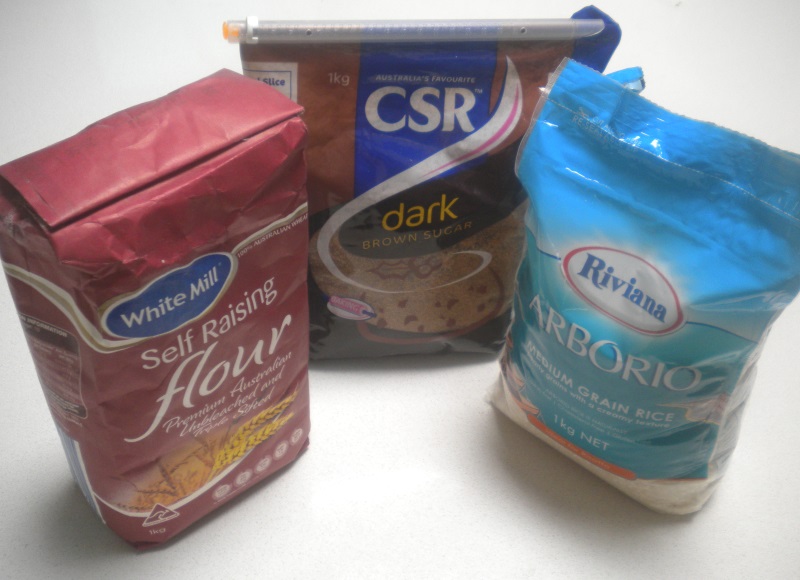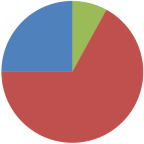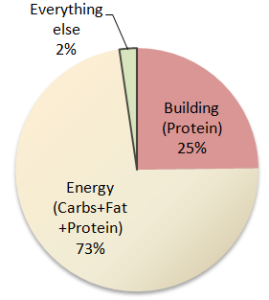Lo-Carb is just shorthand for limiting the amount of Carbohydrates you eat, a method of feeding your body so that it prefers to burn fat.
You may have heard the terms LCHF(Lo-carb, High-fat) / Ketogenic / Atkins / Banting diets. These are all variations on the same theme;
- Remain well hydrated
- Eat minimal Sugar/Starch
- Eat moderate Protein
- Eat plenty of Fat
The purpose is to reduce your risks of Type 2 Diabetes, Heart disease, and Stroke by lowering your Blood pressure, glucose, and your body fat especially around your belly.
That probably sounds like it goes against all common sense – to eat fat to lose fat. As I’ve found out in my own journey, most of the ‘Common Sense‘ we think we know about nutrition is probably marketing. There is a biochemical basis for Carbohydrate restriction, but to discuss that I’m going to have to go back to first principles and discuss food and the mechanisms (homeostasis) that our bodies use to tell us when we need more or have enough.
Water
The Average Adult given access to an abundance of food will Consume around 3 kilos of food a day, over 90% of that is water. Most of that water is likely in the solid foods you eat, but some of it you will also drink. Most of us have a fairly well regulated mechanism for determining how much water we have in our bodies and will function well to make us thirsty if we don’t have enough, or fill our bladders if we have too much.
The first thing you have to control on a Low Carb diet is your hydration. Especially during the early phases as your body adapts to a new source of energy you will
Not Water
So how about the less than 10% of our daily food requirements that aren’t water? About a quarter (the exact fraction is unique for each of us) is raw materials to build and maintain our bodies, most of the rest is used as energy to enable us to hunt down our next meal, and finally a small sliver, about 2% of less than 10% of our food is essential nutrients – minerals (eg: Sodium+Chlorine=Salt) and the handful of chemicals that our bodies need that we can’t create which we often call vitamins (like Ascorbic acid = Vitamin C).
Raw Materials
Our bodies need raw construction materials, proteins from plants and animals that we break down into amino acid building blocks that we then build up into human proteins that we build our bodies out of. The amount your body needs will depend on your size, gender, activity levels, and how much muscle you have. There are also a few specific amino acids you need that you can’t manufacture yourself – but for the sake of simplification we’re going to treat all proteins interchangeably.
The problem with Protein is that while we have a great short term regulator for the amount of protein we require in our food, this system does have some long term consequences. If you have too little in your diet your body will begin to scavenge amino acids by breaking down excess proteins in your body to supplement it’s needs. Too much protein in your diet and your body will just divert it into being used for energy in the short term – but this raises your insulin and as we’ll see in a moment that has some bad long term consequences.
So the second level that we have to stabilise is the amount of protein we eat. If you can keep your daily protein intake in a narrow band (between 0.8g and 1.0g for every kilogram of lean body weight) you’ll keep your muscle and maintain your insulin control.
Energy
Let’s say you have the right levels of water and raw materials to maintain your body, the next most important input is energy to run your body. Your body will need energy just to do nothing except survive – that’s your Basal metabolic rate (BMR) and everyone has a unique rate based on their size, gender, body composition, genetics, among other factors. One study of 150 adults in Scotland found rates from 1000 kcal/day to almost 2500 kcal/day – so the number can vary greatly. Any extra exercise you do during the day will require additional Calories on top of your BMR, and your body uses an elegant signalling mechanisms including hunger and satiety to regulate your energy partitioning.
If you eat too many Calories, you already know what happens. The body stores those calories for a ‘rainy day’ as body fat.
So that’s that then – A Calorie is a Calorie. If you are too fat, then you are eating too much and/or not exercising enough – everything in moderation except Sloth and Gluttony! Right?
So what happened to the elegant signaling mechanism to regulate your energy partitioning?
To understand that we’re going to have to drill into the different forms of food energy – Carbohydrates, Proteins and Fats.
Carbohydrates
Carbohydrates are sugars and starches (which chemically are just long chains of sugars). They include Sucrose in table sugar, Fructose in fruit, even Lactose in milk. They also include the starches in Wheat flour or Rice which the gut easily digests, and the starches in dietary fibre (although as you can’t digest them you can’t turn those into energy). They are one of the cheapest sources of Energy to produce, package, transport and consume.

Your body loves carbohydrates, it turns them easily (those you can digest) into glucose, and every cell in your body can burn that glucose for energy.
The problem with Glucose is that while it is water soluble and can travel freely in the blood, it is quite inflammatory and you can only tolerate a certain level. Above around 5 mmol/l your body will respond (if it can) by making a hormone called insulin that does a bunch of things but one of them is to push glucose floating about in your blood into your muscles to be burned.
Insulin is not just your “lowering sugar” hormone, it is also your “fat storage” hormone. High levels of insulin will tell your liver to convert glucose into fat (triglycerides), tell your fat cells to store those triglycerides. As long as your insulin is high, you will have a hard time trying to burn body fat. It is also becoming clear that insulin also blocks lepton signalling, which is how your gut tells your brain that it has had enough energy (Satiation). Finally having high levels of insulin for long enough, eventually your glucose will drop below the levels that your brain requires (hypoglycemia) which triggers your hunger.
We all have different levels of sensitivity to glucose. Some of us, are extremely sensitive to insulin – our pancreas’ produce a small amount. our muscles respond quickly, our glucose levels drop so our insulin levels go down and if we have available excess body fat we go back to burning it. If you are insulin sensitive your hunger naturally regulates your body weight.
Some of us for a number of reasons (mainly genetic) become insulin resistant. When insulin resistant people eat carbohydrates , our pancreas’ still produce insulin, our skeletal muscles barely respond to insulin and don’t mobilize as much glucose into our muscles, because glucose is still at dangerous levels our pancreas’ produces even more insulin – our levels of insulin remain higher for longer, and of course that means we are stuck in fat storage mode Also because your insulin is high – lepton is blocked and your brain doesn’t get the message that you have taken in enough energy. Finally your insulin is so high that your hypoglycemia lasts longer and 3 hours after eating a meal you will need to have another one.
Another insidious problem of insulin resistance is that your skeletal muscles are not getting enough energy so they send your brain messages to conserve energy. If you are insulin resistant – you will feel lethargic, hungry all the time, and be unable to burn body fat.
Finally for people who have type 2 diabetes (profound insulin resistance) the high levels of Insulin also drive our livers to over produce glucose in a process called gluconeogenesis, which causes our pancreas’ to produce more insulin – it’s what programmers call a positive feedback loop and it means we have high insulin for hours, sometimes even when we’re asleep.
If you can metabolize lots of glucose without getting sick, then if you want to lose weight then all you need is to reduce your total calories, eat from the healthy food pyramid, and do exercise until you lose the amount of weight you want.
If you are insulin resistant you can’t do that – the food pyramid includes food that drives up your insulin, locks your metabolism into fat storage mode, keeps you hungry and tired.
Protein
We already discussed that you need a specific level of Protein to provide raw materials to build and maintain your body. The nutritional range is 0.8g – 1.0g per kg of lean body weight – which is the weight you would be if you had minimal body fat (You can find this number exactly in a DEXA scan, but you can get a rough figure on one of those home scales that calculates %body fat using electrical impedance).
There are long term problems with eating more protein than that. Firstly the biochemistry of burning Protein for energy is inefficient (compared to burning Glucose or Fat). It also produces a lot more waste products that then have to be filtered from the blood by your kidneys, which if you do for a long time will really stress your kidneys.
The Atkins diet originally was a high protein diet. For many people eating too much protein causes nausea, which is the reason I originally left the original atkins diet.
Finally dietary Protein causes an Insulin response, which as we’ve already established has major impacts for people trying to lose body fat – it’s not as dramatic a response as the insulin response to dietary Carbohydrates, but it causes the same problems. If you only eat proteins you’ll eventually have all the problems of eating Carbohydrates plus kidney disease.
Fat
If you can’t eat many Carbohydrates, and can eat only a moderate amount of Protein, then you have to get the majority of your energy from Fat.
The first problem with fat is that it is energy dense – 1g of Carbohydrate contains 4 kcal of energy, 1g of Protein also contains 4 kcal, but 1g of Fat contains 9 kcal, almost twice as much. This is one reason why dieticians traditionally recommend you keep fats to a minimum, and may have something to do with our demonization of lipids.
The next problem is that Fat isn’t Water Soluble, so it can’t ride about in the blood supply unassisted, it would just clump together like an oil slick on a lake. Fat is transported in lipoprotein transports that are colloquially known as Cholesterol. When you eat more Fat you see more Cholesterol in your blood. Not all Cholesterol is bad, and that is a subject I intend to go into a lot more detail on in another post. To summarize the current understanding – only the oxidized small subfraction of LDL is specifically indicated as an indicator of heart disease and those are lowered on a high fat diet and raised on a high carbohydrate diet.
Another problem with Fat is that not every cell in the body can burn Fatty Acids for energy. Red blood cells for example lack a mitochondria, so they can only utilize glucose. Luckily when you unpack the fat storage molecules (triglyceride) in order to oxidize(burn) the fatty acids inside, you are left with a waste product that the liver makes directly into glucose (gluconeogenesis). So the more fat you burn from your love handles the more glucose the liver will make to feed those cells that can only burn glucose.
The final problem with Fat as a fuel source is that it can’t get across the blood brain barrier, so the Brain which is by far the most metabolic (energy hungry) organ in your body can’t be fueled by Fat. When you are predominately burning Glucose, if your blood Glucose level drops below the basic level to fuel your brain (hypoglycemia) you will know about it, as you will receive an urgent message to go buy your brain a candy bar, STAT.
However glucose isn’t the only possible source of energy for the brain or else we wouldn’t have survived the 190+ thousand years of our evolution as a species prior to the discovery of agriculture, and abundant sources of carbohydrates. When you don’t have carbohydrates in your food, you have about a days worth of energy stored in your liver as glycogen. Once you’ve burned through all your glycogen, your liver begins manufacturing chemicals from Fats called Ketone bodies that the brain is quite happy to use for fuel. This process in the liver is called ketogenesis and the state is called ketosis. When you are in this mode because you are eating nothing that is called Starvation ketosis, if however you are creating ketones because you are just not eating Carbohydrates that is called metabolic ketosis.
| blood concentration (millimolar) | Condition |
|---|---|
| < 0.2 | not in ketosis |
| 0.2 – 0.5 | slight/mild ketosis |
| 0.5 – 3.0 | nutritional ketosis |
| 2.5 – 3.5 | post-exercise ketosis |
| 3.0 – 6.0 | starvation ketosis |
| 15 – 25 | ketoacidosis |
Note: There is actually a dangerous level of ketosis that happens only in type 1 diabetics who can’t produce any insulin and haven’t injected any – ketoacidosis. If you mention ketosis to your primary care Doctor and they flip out, they are probably confusing metabolic ketosis with diabetic ketoacidosis. If your body can produce insulin it will, even if you don’t eat any carbohydrates because your liver will be making some which should keep your level of ketone bodies below 6 mmol/l.
The first few days of ketosis are usually rocky because your brain thinks it is starving and all sorts of balances in the body are upset – it’s called keto flu. Once you have been ketogenic for a few weeks it seems that most metabolisms becomes very efficient at creating ketone bodies.
You’ll notice I didn’t mention that eating Fat causes you to get fat, or get Heart disease, or clog your arteries … those are all ‘Common Sense‘ and they are also all wrong. This topic will require several future posts to satisfactorily cover – but for now I might suggest you read Nina Teicholz’ “The Big Fat Surprise” which thoroughly covers the topic.

The Big Fat Surprise by Nina Teicholz
The final thing to note about Fat is that just like there are some essential Amino Acids that your body needs and can’t make itself, there are some essential Fatty Acids (linoleic and α-linolenic acids) you can only get by eating Fats containing them. Also vitamins A, D, E and K are Fat soluble, so the only way to get your daily requirements of those is to eat fats containing them. Both Fat and Protein are therefore essential nutrients, you have to eat them. There is however no obligate requirement for Carbohydrate. There are some vitamins
Lo-Carb macro nutrients
To sum up the ketogenic energy plan then; the goal is to keep the levels of your hormone insulin low to stay in Ketosis. You do that by eating very few Carbohydrates, limiting your Protein intake to the range that your body needs to maintain itself, and get most of your energy from Fats.


